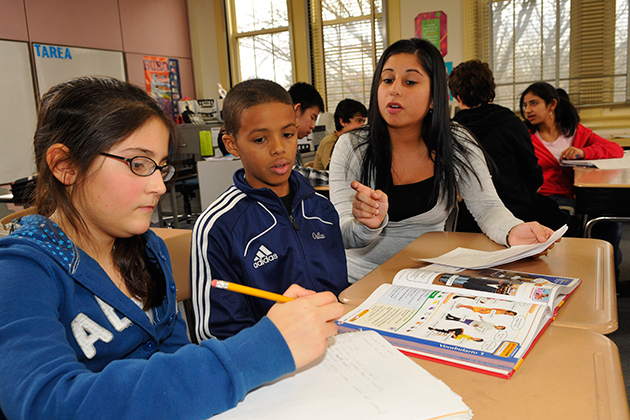Since its founding in 2002, the Center for Clean Energy Engineering (C2E2) at the University of Connecticut has sought to enrich the science and technology education experience for children in grades K-12 through various outreach activities. As the nation’s foremost research and educational center dedicated to the cutting-edge field of fuel cells, the Center seeks to not only acquaint young people with fuel cell technology, but also to inspire future engineers and scientists. On February 16, the Center hosted nearly 50 eighth grade students from the Rogers Park Middle School in Danbury, CT.
Led by science teacher Peter Shaker, the group reflected a blend of students enrolled in two courses: Earth Science and Introduction to Physical Science (IPS). His objective in bringing the Rogers Park group to the Fuel Cell Center in Storrs was to introduce them to an alternative source of energy at a time when oil and gas dominate the U.S. energy landscape. Mr. Shaker also hoped his students would learn first-hand how fuel cells are created and used by exploring them in a fundamental R&D setting, and that they would benefit from meeting practicing scientists.
Mr. Shaker explained that the Earth Science students had been learning about Earth’s atmosphere and how the burning of fossil fuels affects it in the long term. The IPS students studied chemistry for several months in advance of the visit. “Fuel cells connected to both areas nicely,” he remarked.
The morning’s activities kicked off with a general overview presented by Trent Molter, research scientist and business development officer, who delivered an engaging lesson on the basics of energy, its sources and uses. He then presented a more specific discussion of fuel cells, electrolyzers and applications that was augmented by a slide show.
Mr. Molter discussed electrolysis as a process for extracting hydrogen from water. Reformers are used, he explained, to remove hydrogen from hydrocarbons. He described a fuel cell as an electrochemical energy converter that produces only water as a byproduct. Mr. Molter discussed current uses of fuel cells in the NASA space program, including the fleet of space shuttles, in golf carts and utility vehicles, with development efforts today centering on applications in automobiles, boats and other vehicles.
Following the introduction, the class split into subgroups to better accommodate complementary activities conducted in several locations within the Center for Clean Energy Engineering’s facility. Each group participated in all activities, round-robin style. Half assembled into five teams and engaged in hands-on assembly of fuel-cell powered miniature race cars. Each team’s setup included a bright fluorescent lamp, solar cell with electrolyzer, model car and voltmeter. Teams assembled their miniature race cars according to instructions developed by activity leader Dr. Haluk Gorgun, a post-doctoral fellow associated with the Center. This activity culminated in a nail-biting competition among teams to determine which dominated the fuel-cell powered race.
Dr. Frano Barbir, C2E2 professor-in-residence, discussed a micro-miniature fuel cell developed at the Center for field applications by the U.S. Army. Equipped with working samples, Dr. Barbir explained how proton exchange membrane (PEM) fuel cells and solid-oxide fuel cells function. In another nearby lab, research assistant Jesse Hayes demonstrated how fuel cells can be used to power a remote-controlled car, television set and infrared camera displaying actual temperature gradients across the operating fuel cell.
Fourteen-year old Kenny Wallace found the learning experience informative. “I liked the way they were able to gather everyday substances such as hydrogen to make a form of energy,” he said. “One very interesting fact I learned-that I thought was amazing-was how they used simple electrodes to separate the energy and the usable water…–we should really be applying this idea of hydrogen fuel cells to everyday life, because it’s a more healthy and safer form of energy that’s very easily harnessed.”
Mr. Shaker agreed with Kenny’s impressions. “Most of the students came away with a greater knowledge of the uses of hydrogen and a better overall understanding of energy in our world-present and future,” he said. “I was very pleased that the students were focused during the lecture and highly engaged in the activities. The staff at the Center did an excellent job in preparing the activities and keeping the students interested throughout our visit.”
Rogers Park Middle School was founded in the early 1970’s and educates more than 1,000 students in grades 6-8. The eighth grade physical science students have performed well in regional science fair competitions, Mr. Shaker said. In fact, two projects from the school were entered into the Connecticut Science Fair, with one, submitted by two female students, garnering the Young Woman Scientist Award. For this group of promising future scientists and engineers, it’s clear that hands-on learning is sparking excitement and enthusiasm.



